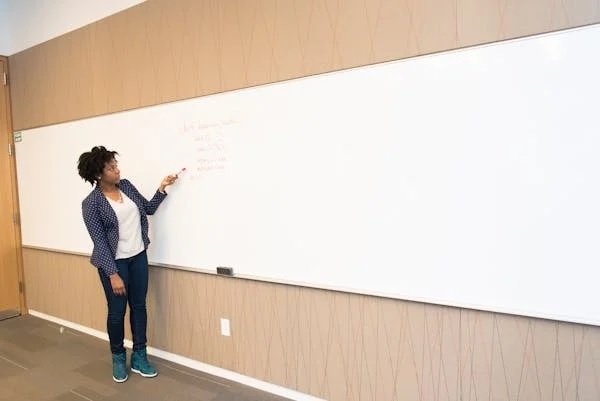In the bustling metropolis of Singapore, innovation and efficiency are cornerstones of daily life. From high-tech offices to modern classrooms, one unassuming tool has proven indispensable: the whiteboard. Its versatility, ease of use, and adaptability make it an essential feature across various sectors, contributing significantly to Singapore’s dynamic environment.
The Rise of the Whiteboard
Whiteboards emerged as a popular alternative to traditional chalkboards in the late 20th century. Their advantages were clear: they eliminated chalk dust, provided a cleaner surface for writing, and allowed for the use of colorful markers that enhanced visual presentations. The adoption of a whiteboard in Singapore mirrored global trends, swiftly becoming a fixture in educational institutions, corporate offices, and even homes.
Whiteboards in Education
Singapore’s education system is renowned for its excellence and innovation. Whiteboards have played a pivotal role in enhancing the learning experience across all levels, from primary schools to universities.
Interactive Learning: Whiteboards facilitate interactive learning. Teachers can quickly jot down notes, draw diagrams, and highlight key points, making lessons more engaging. The ability to erase and rewrite effortlessly encourages a dynamic and fluid teaching style.
Technological Integration: The advent of interactive whiteboards (IWBs) has revolutionized classrooms. These digital whiteboards connect to computers and projectors, allowing teachers to display multimedia content, conduct virtual experiments, and access online resources in real-time. This integration of technology supports diverse learning styles and keeps students engaged.
And, when you integrate a state-of-the-art HD portable bluetooth projector from a brand like Piqo, the interactive learning experience in a classroom becomes exceptionally interactive and immersive. It is a next-generation mini projector that fits in a pocket and provides a cinematic experience. It connects to any device via Bluetooth, Wi-Fi, USB, or HDMI.
Collaboration and Creativity: Whiteboards foster collaboration and creativity among students. Group projects and brainstorming sessions benefit from the large, communal writing space. Students can visually organize their thoughts, share ideas, and work together to solve problems, enhancing teamwork skills.
Corporate Applications
In the corporate world, where ideas and strategies are constantly evolving, whiteboards are indispensable tools for communication and collaboration.
Meetings and Presentations: Whiteboards are essential for meetings and presentations. They provide a platform for illustrating concepts, mapping out plans, and noting feedback. The ability to modify content on the fly makes discussions more interactive and productive.
Project Management: Whiteboards serve as excellent tools for project management. Teams can create visual timelines, track progress, and allocate tasks. The visual nature of whiteboards helps in maintaining clarity and focus, ensuring that everyone is on the same page.
Creative Spaces: Many companies in Singapore are adopting open and creative workspaces. Whiteboards are integral to these environments, providing spaces for spontaneous idea generation and creativity. They allow employees to visualize their thoughts, brainstorm new ideas, and collaborate effectively.
Whiteboards in Homes
The utility of whiteboards extends beyond educational and corporate settings into homes, where they serve various practical purposes.
Family Organization: In busy households, whiteboards are invaluable for organization. Families use them to keep track of schedules, grocery lists, and chores. This central point of communication helps in managing daily activities efficiently.
Study Aid: For students, having a whiteboard at home can be a great study aid. It provides a space for practicing problems, organizing study schedules, and brainstorming ideas. The visual and interactive nature of whiteboards makes studying more effective and engaging.
Creative Expression: Whiteboards also offer a platform for creative expression. Whether used for drawing, doodling, or jotting down inspirational quotes, they add a personal touch to home spaces.
Environmental Considerations
In an era where sustainability is paramount, the environmental impact of whiteboards is a consideration. Traditional whiteboards are made from materials like melamine, porcelain, and glass, each with varying environmental footprints.
Durability and Longevity: High-quality whiteboards, especially those made from porcelain and glass, are durable and long-lasting. Their extended lifespan reduces the frequency of replacement, contributing to lower overall environmental impact.
Eco-friendly Options: There is a growing market for eco-friendly whiteboards made from recycled and sustainable materials. These options provide the same functionality while minimizing environmental harm.
Waste Reduction: Using whiteboards can also contribute to waste reduction. In offices and classrooms, they reduce the need for paper, as notes and information can be displayed and updated digitally or on the board itself.
The Future of Whiteboards
The evolution of whiteboards continues as technology advances. Innovations such as smart whiteboards, which integrate touch technology and internet connectivity, are becoming more prevalent. These smart boards offer advanced features like real-time collaboration, cloud storage, and interactive lessons, further enhancing their utility in various settings.
Hybrid Learning Environments: The COVID-19 pandemic has accelerated the adoption of hybrid learning environments, where digital and physical tools coexist. Whiteboards, especially interactive ones, play a crucial role in these setups by bridging the gap between in-person and remote learning.
Corporate Innovations: In the corporate sector, smart whiteboards are transforming how teams collaborate. Features like remote access, digital note-taking, and integration with other office tools make them indispensable for modern, flexible work environments.
Conclusion
Whiteboards, in their many forms, are integral to the fabric of Singapore’s educational, corporate, and domestic landscapes. Their versatility, coupled with ongoing technological advancements, ensures that they will remain relevant and valuable tools for years to come. As Singapore continues to innovate and evolve, the humble whiteboard will undoubtedly continue to play a significant role in fostering communication, creativity, and collaboration.
